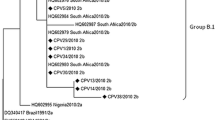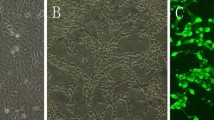Abstract
Canine parvovirus type 2 (CPV-2) emerged in the late 1970 s as a pathogen that is capable of causing high rates of morbidity and mortality in dogs. Currently, three genetic variants circulate worldwide (CPV 2a, 2b, and 2c); however, epidemiological studies have not been conducted in all countries to identify its variants. The objectives of this work were to determine which genotypes of CPV-2 circulate in Mexico and to identify the genetic relationships between CPV-2 sequences from Mexico and those from other parts of the world. Samples from five geographical regions of Mexico were analysed by PCR for identification of CPV-2. Here, 1638 bp of the VP2 gene were amplified and sequenced from 50 CPV-2-positive samples, and a phylogenetic network was assembled using these 50 sequences and 150 others obtained from GenBank, representing different countries around the world. The network showed that the most common genotype circulating in the geographic zones of Mexico was CPV-2c. In the network, the 50 samples were organised into two clusters: cluster I, derived from a group of samples of European origin, which belong to genotype 2c, and cluster II, derived from samples belonging to genotype 2b from the USA. Our data suggest that the CPV-2 strains circulating in Mexico originated from two possible virus introduction events. In addition, high genetic diversity was observed among the CPV-2c-derived sequences, which correspond exclusively to the presence of Mexican CPV-2c haplotypes.


Similar content being viewed by others
References
Agbandje M, Parrish CR, Rossmann MG (1995) The structure of parvoviruses. Semin Virol 6:299–309
Aldaz J, García-Díaz J, Calleros L, Sosa K, Iraola G, Marandino A, Hernández M, Panzera Y, Pérez R (2013) High local genetic diversity of canine parvovirus from Ecuador. Vet Microbiol 166:214–219
Amrani N, Desario C, Kadiri A, Cavalli A, Berrada J, Zro K, Sebbar G, Colaianni ML, Parisi A, Elia G, Buonavoglia C, Malik J, Decaro N (2016) Infect Genet Evol 41:201–206
Bandelt HJ, Forster P, Röhl A (1999) Median-joining networks for inferring intraspecific phylogenies. Mol Biol Evol 16:37–48
Battilani M, Ciulli S, Tisato E, Prosperi S (2002) Genetic analysis of canine parvovirus isolates (CPV-2) from dogs in Italy. Virus Res 83:149–157
Buonavoglia C, Martella V, Pratella A, Tempesta M, Cavalli A, Buonavoglia D, Bozzo G, Elia G, Decaro N, Carmichael L (2001) Evidence for evolution of canine parvovirus type 2 in Italy. J Gen Virol 82:3021–3025
Calderon MG, Mattion N, Bucafusco D, Fogel F, Remorini P, La Torre J (2009) Molecular characterisation of canine parvovirus strains in Argentina: Detection of the pathogenic variant CPV2c in vaccinated dogs. J Virol Methods 159:141–145
Castro TX, Costa EM, Leite JPG, Labarthe NV, Cubel Garcia RCN (2010) Partial VP2 sequencing of canine parvovirus (CPV) strains circulating in the state of Rio de Janeiro, Brazil: Detection of the new variant CPV-2c. Braz J Microbiol 41:1093–1098
Cavalli A, Martella V, Desario C, Camero M, Bellacicco AL, De Palo P, Decaro N, Elia G, Buonavoglia C (2008) Evolution of the antigenic relationships among canine parvovirus type 2 variants. Clin Vaccine Immunol 15:534–569
Chapman MS, Rossmann MG (1993) Structure, sequence and function correlations among parvoviruses. Virology 194:491–508
Cotmore SF, Agbandje-McKenna M, Chiorini JA, Mukha DV, Pintel DJ, Qiu J, Soderlund-Venermo M, Tattersall P, Tijssen P, Gatherer D, Davison AJ (2014) The family Parvoviridae. Arch Virol 159:1239–1247
Decaro N, Buonavoglia C (2012) Canine parvovirus-A review of epidemiological and diagnostic aspects, with emphasis on type 2c. Vet Microbiol 155:1–12
Decaro N, Cirone F, Desario C, Elia G, Lorusso E, Colaianni ML, Martella V, Buonavoglia C (2009) Severe parvovirus in a 12-year-old dog that had been repeatedly vaccinated. Vet Rec 164:593–595
Decaro N, Desario C, Addie DD, Martella V, Vieira MJ, Elia G, Zicola A, Davis C, Thompson G, Thiry E, Truyen U, Buonavoglia C (2007) The study molecular epidemiology of canine parvovirus. Eur Emerg Infect Dis 13:1222–1224
Decaro N, Desario C, Campolo M, Elia G, Martella V, Ricci D, Lorusso E, Buonavoglia C (2005) Clinical and virological findings in pups naturally infected by canine parvovirus type 2 Glu-426 mutant. J Vet Diagn Invest 17:133–138
Decaro N, Desario C, Elia G, Martella V, Mari V, Lavazza A, Nardi M, Buonavoglia C (2008) Evidence for immunisation failure in vaccinated adult dogs infected with canine parvovirus type 2c. New Microbiol 31:125–130
Decaro N, Desario C, Parisi A, Martella V, Lorusso A, Miccolupo A, Mari V, Colaianni ML, Cavalli A, Di Trani L, Buonavoglia C (2009) Genetic analysis of canine parvovirus type 2c. Virology 385:5–10
Decaro N, Martella V, Elia G, Desario C, Campolo M, Lorusso E, Colaianni ML, Lorusso A, Buonavoglia C (2007) Tissue distribution of the antigenic variants of canine parvovirus type 2 in dogs. Vet Microbiol 121:39–44
Duque-García Y, Echeverri-Zuluaga M, Trejos-Suarez J, Ruiz-Saenz J (2017) Prevalence and molecular epidemiology of canine parvovirus 2 in diarrheic dogs in Colombia, South America. A possible new CPV-2a is emerging? Vet Microbiol 201:56–61
Faz M, Martinez JS, Quijano I, Fajardo R (2017) Reliability of clinical diagnosis and laboratory testing techniques currently used for identification of canine parvovirus enteritis in clinical settings. J Vet Med Sci 79:213–217
Filipov C, Desario C, Patouchas O, Eftimov P, Gruichev G, Manov V, Filipov G, Buonavoglia C, Decaro N (2016) A ten-year molecular survey on parvoviruses infecting carnivores in Bulgaria. Transbound Emerg Dis 63:460–464
Gallo Calderón M, Wilda M, Boado L, Keller L, Malirat V, Iglesias M, Mattion N, La Torre J (2012) Study of canine parvovirus evolution: comparative analysis of full-length VP2 gene sequences from Argentina and international field strains. Virus Genes 44:32–39
Gámiz C, Martella V, Ulloa R, Fajardo R, Quijano-Hernandéz I, Martínez S (2011) Identification of a new genotype of canine distemper virus circulating in America. Vet Res Commun. 35:381–390
Grecco S, Iraola G, Decaro N, Alfieri A, Gallo Calderon M, da Silva AP, Name D, Aldaz J, Calleros L, Marandino A, Tomás G, Maya L, Francia L, Panzera Y, Perez R (2018) Inter-and intracontinental migrations and local differentiation have shaped the contemporary epidemiological landscape of canine parvovirus in South America. Virus Evol 4:vey 011
Hong C, Decaro N, Desario C, Tanner P, Pardo MC, Sanchez S, Buonavoglia C, Saliki JT (2007) Occurrence of canine parvovirus type 2c in the United States. J Vet Diagn Invest 19:535–539
Kapil S, Cooper E, Lamm C, Murray B, Rezabek G, Johnston L, Campbell G, Johnson B (2007) Canine parvovirus types 2c and 2b circulating in North American dogs in 2006 and 2007. J Clin Microbiol 45:4044–4047
Kumar M, Nandi S (2010) Molecular typing of canine parvovirus variants by polymerase chain reaction and restriction enzyme analysis. Transbound Emerg Dis 57:458–463
Mira F, Dowgier G, Purpari G, Vicari D, Di Bella S, Macaluso G, Gucciardi F, Randazzo V, Decaro N, Guercio A (2018) Molecular typing of a novel canine parvovirus type 2a mutant circulating in Italy. Infect Genet Evol 61:67–73
Mira F, Purpari G, Lorusso E, Di Bella S, Gucciardi F, Desario C, Macaluso G, Decaro N, Guercio A (2018) Introduction of Asian canine Parvovirus in Europe through dog importation. Transbound Emerg Dis 65:16–21
Miranda C, Parrish CR, Thompson G (2016) Epidemiological evolution of canine parvovirus in the Portuguese domestic dog population. Vet Microbiol 183:37–42
Miranda C, Thompson G (2016) Canine parvovirus: the worldwide occurrence of antigenic variants. J Gen Virol 97:2043–2057
Nakamura M, Tohya Y, Miyazawa T, Mochizuki M, Phung HT, Nguyen NH, Huynh LM, Nguyen LT, Nguyen PN, Nguyen PV, Nguyen NP, Akashi H (2004) A novel antigenic variant of canine parvovirus from a Vietnamese dog. Arch Virol 149:2261–2269
Nandi S, Kumar M (2010) Canine parvovirus: current perspective. Indian J Virol 21:31–44
Ohneiser SA, Hills SF, Cave NJ, Passmore D, Dunowska M (2015) Canine parvoviruses in New Zealand form a monophyletic group distinct from the viruses circulating in other parts of the world. Vet Microbiol 178:190–200
Pedroza-Roldan C, Paez-Magallan V, Charles-Nino C, Elizondo-Quiroga D, Leonel De Cervantes-Mireles RR, Lopez-Amezcua MA (2015) Genotyping of canine parvovirus in western Mexico. J Vet Diagn Invest 27:107–111
Pérez R, Francia L, Romero V, Maya L, López I, Hernández M (2007) First detection of canine parvovirus type 2c in South America. Vet Microbiol 124:147–152
Prittie J (2004) Clinical practice review canine parvoviral enteritis: a review of diagnosis, management, and prevention. J Vet Emerg Crit Care 14:167–176
Shackelton LA, Parrish CR, Truyen U, Holmes EC (2005) High rate of viral evolution associated with the emergence of carnivore parvovirus. Proc Natl Acad Sci USA 102:379–384
Stephano H (1980) Epizootia de enteritis viral canina en Mexico. Posible infeccion por parvovirus. Vet Mex 11:141–148
Tamura K, Stecher G, Peterson D, Filipski A, Kumar S (2013) MEGA6: molecular evolutionary genetics analysis version 6.0. Mol Biol Evol 30:2725–2729
Touihri L, Bouzid I, Daoud R, Desario C, El Goulli AF, Decaro N, Ghorbel A, Buonavoglia C, Bahloul C (2009) Molecular characterisation of canine parvovirus-2 variants circulating in Tunisia. Virus Genes 38:249–258
Truyen U (2006) Evolution of canine parvovirus—a need for new vaccines? Vet Microbiol 117:9–13
Tu M, Liu F, Chen S, Wang M, Cheng A (2015) Role of capsid proteins in parvoviruses infection. Virol J 12:114
Acknowledgements
The authors would like to thank Universidad Autónoma de Estado de México for the financial support awarded to this project, to all participating veterinarians for the submission of clinical samples, and MSD Animal Health for their collaboration in this project. Mirna Faz would like to thank Conacyt for the scholarship 56534 for postgraduate studies in Universidad Autónoma del Estado de México, Programa de Maestría y Doctorado en Ciencias Agropecuarias y Recursos Naturales.
Author information
Authors and Affiliations
Corresponding author
Ethics declarations
Conflict of interest
The authors declare no conflict of interest.
Additional information
Handling Editor: Sheela Ramamoorthy.
Electronic supplementary material
Below is the link to the electronic supplementary material.
Rights and permissions
About this article
Cite this article
Faz, M., Martínez, J.S., Gómez, L.B. et al. Origin and genetic diversity of canine parvovirus 2c circulating in Mexico. Arch Virol 164, 371–379 (2019). https://doi.org/10.1007/s00705-018-4072-7
Received:
Accepted:
Published:
Issue Date:
DOI: https://doi.org/10.1007/s00705-018-4072-7




